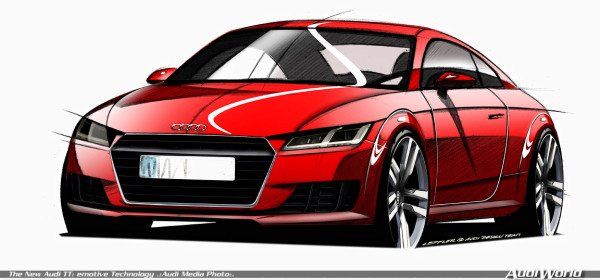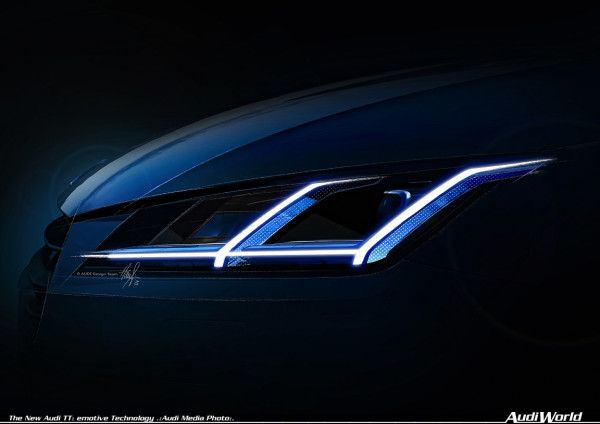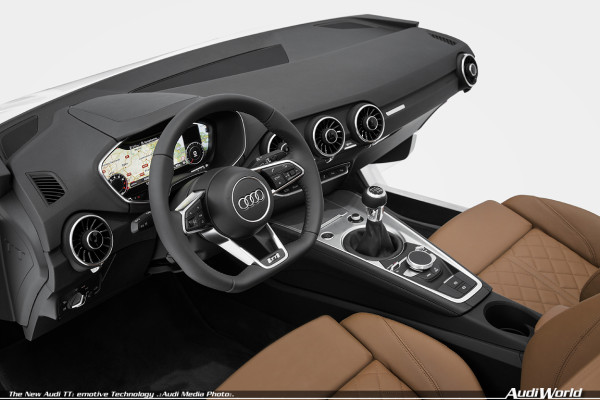The New Audi TT: emotive Technology

Design
Even at first glance, the third-generation Audi TT is every inch the sports car – masculine and muscular. Its body shell taut and athletic. The Audi designers have returned to many of the design ideas from the original TT and placed them in an entirely new context.
The design history
When the first-generation Audi TT came on the market in 1998 it was a design revolution – its strictly geometrical, formally coherent design language reminiscent of the Bauhaus art movement of the 1920’s. The entire design concept was centered around the circle; the curves of the roof, front and rear end contrasting perfectly with its horizontal contours. This clean and timeless design secured the TT the status of a design icon right from the time it was launched. At the same time, the TT provided strong impetus for the Audi brand to develop further.
The exterior design of the new TT
The front of the new TT is dominated by horizontal lines. The single-frame six-corner grille – similar to that found on the R8 high-performance sports car – is very broad and flat, with a powerful line dividing it into two zones. The flat headlights are situated immediately below the hood, their lower edge in line with a contour extending from both sides of the grille. Sculptured sections connecting the grille and headlights are typical design features of the new TT and only add to its distinctive look.
Starting in the top corners of the grille, sharp contours run in a V across the hood, which bears the four Audi rings – once again reminiscent of the R8. Both of the large air intakes feature two slightly angled struts that direct part of the flow away from the front to the flanks. A third, flat opening beneath the single-frame connects the two intakes with one another, forming the third horizontal line along the front of the new TT.
Longer wheelbase, shorter overhangs
From the side, the new Audi TT is equally lean and muscular; it rests low on the road as if ready to pounce. At 4177 mm (13.70 feet), the Coupé is exactly one millimeter shorter than its predecessor, although its wheelbase has grown by 37 mm (1.46 inches) to 2505 mm (8.22 feet), making for especially short overhangs. It is 1832 mm (6.01 feet) wide (10 mm less than its predecessor), and the same height as its predecessor at 1353 mm (4.44 feet).
A wealth of details featured on the new Audi TT’s profile are reminiscent of the first generation of the classic. Together with the door (which features gently rounded rear corners), the fluid dynamic line of the sill creates a striking refracting edge, while the broad wheel arches form their own geometric bodies. The front wheel arch breaches the line of the hood, which continues over the door as a tornado line and runs almost horizontally through to the tail as a strong body shoulder, culminating elegantly at the tail lights. The door handles boast a sturdy bow-shaped design, while the side mirrors sit atop the body shoulder – in typical sports car fashion; their slender bases are designed for enhanced aerodynamic and aeroacoustic performance.
In a design reminiscent of the first-generation TT, the flat glass housing also gives the impression of being a separate unit, and the slight kink in the rear side window draws attention to the powerful C-pillars. The circular fuel flap on the right side panel opens with a gentle tap. What is new is that there is no fuel tank cap beneath the flap. The filler nozzle slots straight into the tank filler, just like in motor racing.
The tail of the new Audi TT is compact and powerful, the interplay of light and shade serving to enhance the impression of fluidity. Here too, three horizontal lines – beneath the tail lights, license plate and above the diffuser – underline the impression of the new TT’s sporty width. At 120 km/h (74.56 mph), a spoiler extends from the luggage compartment lid to improve downforce on the rear axle.
The latest generation features two large round exhaust tailpipes positioned relatively close to one another in the diffuser, again a return to the original design. The heavily rounded rear window is similarly reminiscent of the first TT, as are the smoothly integrated one-piece tail lights and the three-dimensional, precision-manufactured lettering.
Seven new exterior colors
A total of 11 exterior colors are available for the new Audi TT; seven of these are new colors for the TT and three in particular deserve a mention: Tango Red metallic is an intense, vibrant red that emphasizes the contours of the Coupé particularly well, Nano Gray metallic is clean and pure, while Vegas Yellow screams sportiness. Daytona Gray metallic is available exclusively for the S line, an optional exterior package that makes the design of the bumpers, air intakes, single-frame grille, sills and rear diffuser even sharper and sportier.
The striking design details, some in eye-catching aluminum, emphasize the status of the Audi TTS. The single-frame grille features striking double horizontal struts with a matt platinum gray insert. The three front air intakes are separated from one another, surrounded by strong contours with horizontal bars structuring the inside. The striking mirror housings and clearly defined sills are a highlight of the flanks, while the tail features an enlarged, fluted diffuser surrounding the four tailpipes of the exhaust. The crystal-effect Panther Black and the Sepang Blue metallic colors are only available for the TTS.

The headlight design
The flat headlights give the new TT front end a determined look. Xenon plus units are standard, their LED daytime running lights forming a curve along the top edge. The turn signal is situated between this and a horizontal design cover.
LED headlights or – shortly after the launch date – headlights in pioneering Audi Matrix LED technology are available from Audi as an option. In both cases, the daytime running light has a highly original signature with one horizontal and two vertical bars giving the headlights their structure. This new look is highly reminiscent of the R18 e-tron quattro lights; this car will be racing at Le Mans in 2014. LEDs illuminate the bars through the thick-wall optics. The turn signal strip is situated at the lower edge of the headlights.
With the Matrix LED headlights, which will be available shortly after market launch, the new Audi TT is setting new standards for its class. Here, the high beam is divided into 12 small light emitting diodes per unit, two reflectors with five LEDs and one reflector with two LEDs. These LEDs are individually controllable by the control unit, which communicates with a camera on the interior mirror and switches them on and off in response to the current road situation. There are a total of 64 dimming stages.
This finely tuned technology allows the headlight system to realize several hundred million light distributions, meaning that it can always prevent oncoming vehicles or vehicles ahead from being dazzled and ensure that the road is always perfectly lit. Intelligent bend lighting is an additional function of the Matrix LED headlights, and is created as a result of light center displacement. Together with MMI Navigation plus, which is available as an option, the control unit uses the route data to move the cone of light into the curve before the steering wheel is turned.
The Matrix LED headlights are supplied with dynamic turn signals that light up sequentially in the direction in which the driver is steering. It takes 150 milliseconds for them all to light up and they then remain illuminated for 250 milliseconds, after which they are extinguished and the process starts again. The dynamic turn signals are easy to see by other road users even in poor visibility and from long distances.
The design features of the front headlights are repeated in the tail lights of the new Audi TT. The tail lights, which feature three bars made from homogenizing plastic material, emit light constantly without requiring driver activation. The brake lights and rear fog lights are situated in the large upper segments of the lights, while the turn signal is situated in the smaller lower part.
The third brake light is an extremely narrow strip positioned under the edge of the rear lid and plays a vital role in defining the tail light silhouette. In models equipped with LED headlights, the tail lights also have dynamic turn signals.

The interior design
Clearly structured elements with taut surfaces; clean, simple contours and light, almost floating lines – just as with the exterior, the interior embodies the pure sports car feel of the new Audi TT. Horizontal lines and surfaces emphasize the width of the interior. In traditional TT fashion, the center tunnel console supports the calves of the driver and front passenger, and the armrests in the door trim have similar flowing shapes.
Seen from above, the instrument panel, the central area of which is angled toward the driver, resembles the wing of an aircraft; the round air vents – another classic TT feature – are reminiscent of jet engines with their turbine-like design. The rotary controls for seat heating, air circulation, temperature, air distribution and air flow strength are located at their center. The setting selected is shown on small displays in the automatic air conditioning system – the center of the vents remains stationary whatever the setting.
The absence of a traditional HVAC control unit has given the Audi designers the freedom to create a clutter-free, ultra-clean instrument panel. This lean architecture has also been achieved through the Audi virtual cockpit; by combining the instrument cluster and MMI monitor into a digital unit, there is no longer any need for a central screen. In line with the sports car feel flowing through the car, the entire interior of the new Audi TT is focused on the driver.
Beneath the three central air vents there are switches to activate the hazard warning lights, Audi drive select and additional functions; these switches are separated from one another by thin bars. The center tunnel console – a standalone unit that is visually separated from the instrument panel – features the gear lever or selector lever, the start/stop button, a dial for controlling audio volume, the new MMI terminal and the electromechanical parking brake activation button.
The three-spoke sports steering wheels also have a new design. All versions feature a flattened rim, and aluminum-look clasps encompass the wide, open spokes. The S line models feature an S line badge in the lower spoke and contrasting colored stitching. The TTS models feature a TTS badge as well as characteristic double stitching on the rim.
The expert touch of the Audi designers is also evident in the colors and materials of the new TT and TTS. Fabric upholstery is available as standard for the seats, with Milano leather or pearl Nappa leather/Alcantara combination upholstery available as an option. The shoulder area of the S line sports package is upholstered in velvet leather. Fine Nappa leather is also available as an option for the S sports seats, which feature characteristic diamond quilting as standard.
Interior colors Black, Rock Gray and Palomino Brown are available for the TT and TTS, the color Rotor Gray is available for the S line sports package, and Express Red is additionally available for the TTS. These colors can be found on the armrests, in the door trims and on the seats. In models fitted with the S sports seats, the trims on the flanks and rear of the seats and some parts of the center tunnel console feature coordinating colors. For the TT, for example, the colors metallic gray, white and bronze are available for these zones; for the S line sports package and TTS the colors available are Quartz Anthracite or Silver.
Many of the controls feature aluminum-effect accents, while red decorative rings are also available for the TTS air vents. The aluminum package, which is also available as an option, includes the center tunnel console trim and door pull handle inserts made from solid metal; this touch adds an extra special finish.
Three leather packages are also available. One special highlight is the Audi Murillo Brown design selection, which combines two leather colors: dark brown on the seats and a Stone Gray in the cockpit area. Both leather colors boast contrasting stitching. The dark-gray aluminum trims and special woven floor mats – similar to those available with the TTS – are yet more features that lend the interior a pronounced sporty look and feel.
As a 2+2 seater, the new Audi TT is a sports car that is highly suitable for everyday use. The rear seat backrests can be folded separately, while the luggage compartment boasts a capacity of 305 liters (10.77 cubic feet) – an increase of 13 liters (0.46 cubic feet).
